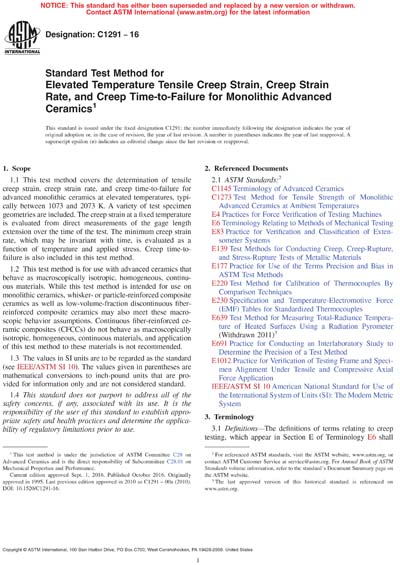Historical
ASTM C1291-16
Standard Test Method for Elevated Temperature Tensile Creep Strain, Creep Strain Rate, and Creep Time-to-Failure for Monolithic Advanced Ceramics
1.1 This test method covers the determination of tensile creep strain, creep strain rate, and creep time-to-failure for advanced monolithic ceramics at elevated temperatures, typically between 1073 and 2073 K. A variety of test specimen geometries are included. The creep strain at a fixed temperature is evaluated from direct measurements of the gage length extension over the time of the test. The minimum creep strain rate, which may be invariant with time, is evaluated as a function of temperature and applied stress. Creep time-to-failure is also included in this test method.
1.2 This test method is for use with advanced ceramics that behave as macroscopically isotropic, homogeneous, continuous materials. While this test method is intended for use on monolithic ceramics, whisker- or particle-reinforced composite ceramics as well as low-volume-fraction discontinuous fiber-reinforced composite ceramics may also meet these macroscopic behavior assumptions. Continuous fiber-reinforced ceramic composites (CFCCs) do not behave as macroscopically isotropic, homogeneous, continuous materials, and application of this test method to these materials is not recommended.
1.3 The values in SI units are to be regarded as the standard (see IEEE/ASTM SI 10). The values given in parentheses are mathematical conversions to inch-pound units that are provided for information only and are not considered standard.
1.4 This standard does not purport to address all of the safety concerns, if any, associated with its use. It is the responsibility of the user of this standard to establish appropriate safety and health practices and determine the applicability of regulatory limitations prior to use.
ASTM International [astm]

